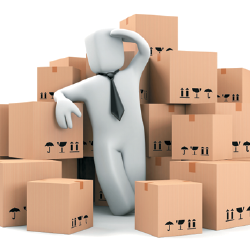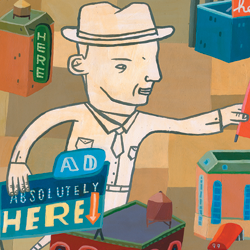|
REGISTRATION REQUIRED
exhibiting 101
 Where There's Smoke...
"Fire!" is the last thing an exhibitor wants to hear on the trade show floor. A thorough understanding of common industry rules and regulations can keep your exhibit from feeding the flames.
Most folks think an exhibit fire will never happen to them. It's sort of like winning the lottery or being hit by lighting: It always happens to someone else. But I've had five small fires in my exhibits during my career – three from halogen lighting, one from computers in an enclosed space without adequate ventilation, and another caused by overheated truck brakes. Luckily, all these conflagrations resulted in only minor damage, and no one was injured.
Because of my history of bad luck with booth blazes, I'm a big fan of fire marshals who work to keep exhibitors, show attendees, and the venue safe. Their advice is free for the asking, and they truly want us to take advantage of their expertise in fire safety. The following information comes from my conversations with these valuable show-floor allies, the industry fire standards published by the National Fire Protection Association (NFPA), and the school of hard knocks. Exhibit Materials I've been asked by exhibitors, "Whose job is it to make sure I'm complying with all the fire rules and regulations?" As exhibitors, we can't abdicate the responsibility for adhering to fire safety rules to our exhibit house, although as professionals at their craft, they should be aware of the industry standards for the materials used. Your exhibit house should also provide you with a Certificate of Flame Retardancy for materials used in your exhibit that could be questioned by the fire marshal. But it's ultimately the responsibility of exhibit managers to make sure their exhibit is in compliance with the published fire safety regulations. So do your research on regional and venue-specific ordinances, and when in doubt, call the fire marshal directly and ask. All materials used in your exhibit must be either flame resistive, flame resistant, or flame retardant. (The terms "fireproof" and "flameproof" are considered inappropriate and misleading.) Although these may all sound like the same thing, each has a specific definition. Fire/flame resistive is the highest level of protection and refers to materials that do not burn or support combustion. Flame resistant is the second level of protection and refers to materials that by design, composition, or inherent noncombustible nature do not support a flame from an outside heat source; they self-extinguish. Flame retardant is the third and lowest level of protection and includes materials that have been treated with a noncombustible substance to make them less of a hazard. Fire-retardant substances can be incorporated to the materials during manufacturing, added commercially after manufacturing, or applied in the field by trained professionals. In addition to the requirement that all materials be flame resistive, flame resistant, or flame retardant, there are other regulations for specific materials often used in exhibit construction. If your exhibit – or any part of your exhibit – fails to meet code, it may be ordered dismantled and removed from the show floor. This is a rare occurrence, as fire marshals will generally work with you to solve the problem if at all possible. But understanding the regulations and making sure your exhibit and its materials meet those requirements will save you an inordinate amount of time and stress and help ensure a successful show for you and your company. Here then are the general guidelines for wood, carpet, and fabric. ➤ Wood: The NFPA Standard 703 clearly states that "Wood shall be greater than one-fourth inch nominal thickness or wood not greater than one-fourth inch thickness shall be treated, fire retardant wood."➤ Carpet: Commercial carpet is classified by testing laboratories that use a nationally recognized standard for combustibility. Class 1 or A carpets offer the highest level of fire protection, while Class 3 or C carpets offer the lowest. Even the double-sided tape used to secure the carpet to the floor should be the same or better rating than the carpet. Nonrated, residential carpet is banned from use in public buildings, so don't think that a trip to a big-box home store will save you in the event of a last-minute carpet catastrophe. Fire marshals can generally spot a home-built exhibit from across the show floor, and they're under no obligation to overlook your quick flooring fix. ➤ Fabric: All materials must be either made of noncombustible components or treated with a flame retardant. See NFPA 701 for textiles and films and Underwriters Laboratories (UL) statute 1975 for foamed plastics. Covered and Double-Deck Exhibits Building an enclosed or double-deck exhibit in a convention hall is literally constructing a building inside a building. To make sure that both buildings are as safe as possible from fire, you will likely have to take extra measures to satisfy local regulations. Depending on the individual convention center and its type of fire-suppression system, exhibitors may be required to install either approved smoke detectors with audible alarms or full sprinkler systems in exhibits with covered areas, as the ceiling would prevent the building's sprinkler system from discharging water unobstructed to the floor, which is where most fires start. If you are planning on using either multilevel exhibits or exhibits with enclosed areas, your best bet is to contact the convention center's fire marshal and his or her counterpart, the structural engineer, to determine the specific rules and regulations as soon as you start planning your exhibit. The fire marshal will generally request a copy of your exhibit plan for approval. Depending on the city and convention center, there may be a charge for reviewing and (hopefully) approving your design. Keep in mind that fire regulations extend to the stairs leading to your double deck's upper level. My second-story hospitality area was once shut down because while the steps themselves were wide enough to meet code, they were ultimately deemed too narrow because the hand railing extended 3 inches from the wall. Luckily, the area was reopened after we agreed to hire a fire watch person who was posted at the bottom of the stairs. While it is rare, I have seen fire marshals cordon off entire double-deck exhibits that fail to meet code. That means no one – attendees or staffers – is allowed inside. Having a clear understanding of the regulations that apply to the show venue and securing written approval of your exhibit plan is essential if you hope to exhibit in a double deck without fear of breaching fire-safety rules. Exhibit Lighting Since the use of cooler-operating LEDs has dramatically increased, the industry has seen fewer accidents caused by overheated halogen bulbs. In fact, the Las Vegas Convention Center (LVCC) has banned the used of 100-watt halogen stem lights with linear quartz bulbs or non-shielded halogen bulbs since 2003, citing research that halogen bulbs are routinely handled with bare hands. This leaves a residue of body oil that creates hot spots that can cause the bulbs to explode. But before going out and replacing all of your halogen fixtures, be sure to check the specific regulations at your show venue, as they may still allow halogen bulbs. Electrical Standards Electrical installations must conform to the Uniform Building Code and the National Electric Code. All electrical equipment must be UL approved, all extension cords must have grounded plugs (three-wire UL approved), and only multiplug adapters with built-in overload protection (aka surge protectors) are allowed. Cube taps, which convert one electrical socket into three to six sockets, are prohibited because of potential overloads. Furthermore, most convention centers only allow flat extension cords that contain a minimum of 14-gauge wire. Electrical work under exhibit carpeting must be done or supervised by the general service contractor's designated electrical contractor. In most venues, hard-wall exhibits must be a minimum of 9 inches from the rear booth line for access to electrical wiring running behind it. If your display involves water, you may be required to protect the equipment with a ground fault interrupter (GFI) device to prevent electrical shock. But even proper wiring does not ensure your electrical equipment is completely safe from harm. Computers, servers, and other tech devices can easily overheat and cause a conflagration in an enclosed space. To avoid that red-hot nightmare, work with your exhibit house to make sure you have adequate airflow around any electrical equipment. Exits and Exit Signs Exhibits can't obstruct exit doors nor the view of exit signs. They also can't obstruct fire-hose or fire-apparatus cabinets, fire-alarm pull stations, or sprinkler closets; these must be visible and accessible at all times. Depending on the venue, a clearance of 3 to 10 feet must be left unobstructed between fire apparatuses and exhibit properties. Also, if the crowd gathering around your exhibit overflows and blocks the show aisles, don't be surprised to get a visit from the fire marshal, since maintaining open aisles and access to egress from the building are also part of his or her responsibilities. Literature Storage Since exhibitors' collateral literature is generally flammable, most fire marshals limit exhibitors to a one-day supply of literature and prohibit the storage of cardboard boxes within their exhibit space. Others take it a step further and state that they will physically remove excess literature and store it at the exhibitors' expense. So check with the GSC on the availability of accessible storage to hold superfluous collateral. If you're unable to locate suitable storage, consider leaving the extra literature in your hotel room and replenishing the in-booth supply when you return to the convention center each morning. Although many exhibiting rules are bendable on a case-by-case basis, fire safety is not something to mess around with. While this article covers some of the common fire regulations, it is by no means a replacement for reading – and re-reading – the guidelines and requirements printed in the exhibitor services manual specific to your show and its venue. After all, it's better to be safe than charry! E
Fuel for the Fire
You may need special permits and/or written approval from the fire marshal if you plan to use, display, or store the following items in your exhibit. Local fire regulations also may require additional portable fire extinguishers or smoke alarms in your booth to supplement the fire-control equipment provided by the venue. ➤ Any open flame for product demonstration or decorative purposes ➤ Flammable liquids ➤ Liquefied petroleum gases ➤ Pressurized (i.e., aerosol) containers with flammable propellants ➤ Compressed gases used for demonstration purposes ➤ Cryogenic liquids ➤ Pyrotechnics and explosives ➤ Indoor cooking/baking appliances, which must be placed on noncombustible surfaces and separated from any combustibles in your display ➤ Hazardous displays, such as demonstrations of lasers ➤ Hazardous chemicals, pesticides, or herbicides (quantities generally limited to one quart of liquid chemicals and two pounds of solid chemicals for demonstration purposes) ➤ Any vehicle or equipment with an internal-combustion engine (Many venues have restrictions regarding how much fuel is allowed in the tanks of vehicles brought to the show floor.)  Candy Adams
Candy AdamsCTSM, CEM, CMP, CMM "The Booth Mom," is an independent exhibit project manager, trainer, speaker, consultant, and an Exhibitor Conference faculty member. CandyAdams@BoothMom.com
|
|
|
||||||||||||||||||||||||||||
|
|
||||||||||||||||||||||||||||
|
TOPICS Measurement & Budgeting Planning & Execution Marketing & Promotion Events & Venues Personal & Career Exhibits & Experiences International Exhibiting Resources for Rookies Research & Resources |
MAGAZINE Subscribe Today! Renew Subscription Update Address Digital Downloads Newsletters Advertise |
FIND IT Exhibit Producers Products & Services All Companies Get Listed |
EXHIBITORLIVE Sessions Exhibit Hall Exhibit at the Show Registration |
ETRAK Sessions Certification F.A.Q. Registration |
EDUCATION WEEK Overview Sessions Hotel Registration |
CERTIFICATION The Program Steps to Certification Faculty and Staff Enroll in CTSM Submit Quiz Answers My CTSM |
AWARDS Exhibit Design Awards Portable/Modular Awards Corporate Event Awards Centers of Excellence |
NEWS Associations/Press Awards Company News International New Products People Shows & Events Venues & Destinations EXHIBITOR News |
||||||||||||||||||||
|
||||||||||||||||||||||||||||






